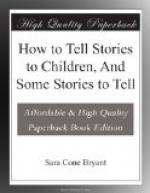For this, and for poetic presentation of truths in easily assimilated form, and because it gives joyous stimulus to the imagination, and is necessary to full appreciation of adult literature, we may freely use the wonder tale.
Closely related to, sometimes identical with, the fairy tale is the old, old source of children’s love and laughter,
THE NONSENSE TALE
Under this head I wish to include all the merely funny tales of childhood, embracing the cumulative stories like that of the old woman and the pig which would not go over the stile. They all have a specific use and benefit, and are worth the repetition children demand for them. Their value lies, of course, in the tonic and relaxing properties of humour. Nowhere is that property more welcome or needed than in the schoolroom. It does us all good to laugh, if there is no sneer nor smirch in the laugh; fun sets the blood flowing more freely in the veins, and loosens the strained cords of feeling and thought; the delicious shock of surprise at every “funny spot” is a kind of electric treatment for the nerves. But it especially does us good to laugh when we are children. Every little body is released from the conscious control school imposes on it, and huddles into restful comfort or responds gaily to the joke.
More than this, humour teaches children, as it does their grown-up brethren, some of the facts and proportions of life. What keener teacher is there than the kindly satire? What more penetrating and suggestive than the humour of exaggerated statement of familiar tendency? Is there one of us who has not laughed himself out of some absurd complexity of over-anxiety with a sudden recollection of “clever Alice” and her fate? In our household clever Alice is an old habituee, and her timely arrival has saved many a situation which was twining itself about more “ifs” than it could comfortably support. The wisdom which lies behind true humour is found in the nonsense tale of infancy as truly as in mature humour, but in its own kind and degree. “Just for fun” is the first reason for the humorous story; the wisdom in the fun is the second.
And now we come to
THE NATURE STORY
No other type of fiction is more familiar to the teacher, and probably no other kind is the source of so much uncertainty of feeling. The nature story is much used, as I have noticed above, to illustrate or to teach the habits of animals and the laws of plant-growth; to stimulate scientific interest as well as to increase culture in scientific fact. This is an entirely legitimate object. In view of its present preponderance, it is certainly a pity, however, that so few stories are available, the accuracy of which, from this point of view, can be vouched for. The carefully prepared book of to-day is refuted and scoffed at to-morrow. The teacher who wishes to use story-telling chiefly as an element in nature study must at least limit herself to a small amount of absolutely unquestioned material, or else subject every new story to the judgment of an authority in the line dealt with. This is not easy for the teacher at a distance from the great libraries, and for those who have access to well-equipped libraries it is a matter of time and thought.




